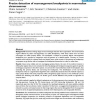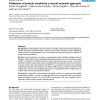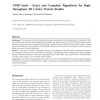BMCBI
2008
13 years 11 months ago
2008
Background: Compared to other omics techniques, quantitative metabolomics is still at its infancy. Complex sample preparation and analytical procedures render exact quantification...
BMCBI
2008
13 years 11 months ago
2008
BMCBI
2008
13 years 11 months ago
2008
Background: Post-translational modifications have a substantial influence on the structure and functions of protein. Post-translational phosphorylation is one of the most common m...
BMCBI
2008
13 years 11 months ago
2008
BMCBI
2008
13 years 11 months ago
2008
Background The use of clustering methods for the discovery of cancer subtypes has drawn a great deal of attention in the scientific community. While bioinformaticians have propose...
BMCBI
2008
13 years 11 months ago
2008
The G-protein coupled receptor (GPCR) superfamily is currently the largest class of therapeutic targets. In silico prediction of interactions between GPCRs and small molecules is ...
BMCBI
2008
13 years 11 months ago
2008
Background: The development and improvement of reliable computational methods designed to evaluate the quality of protein models is relevant in the context of protein structure re...
BMCBI
2008
13 years 11 months ago
2008
Background: In DNA microarray experiments, discovering groups of genes that share similar transcriptional characteristics is instrumental in functional annotation, tissue classifi...
BMCBI
2008
13 years 11 months ago
2008
Background: We present a novel method of protein fold decoy discrimination using machine learning, more specifically using neural networks. Here, decoy discrimination is represent...
BMCBI
2008
13 years 11 months ago
2008
Background: The principles of protein folding and evolution pose problems of very high inherent complexity. Often these problems are tackled using simplified protein models, e.g. ...



